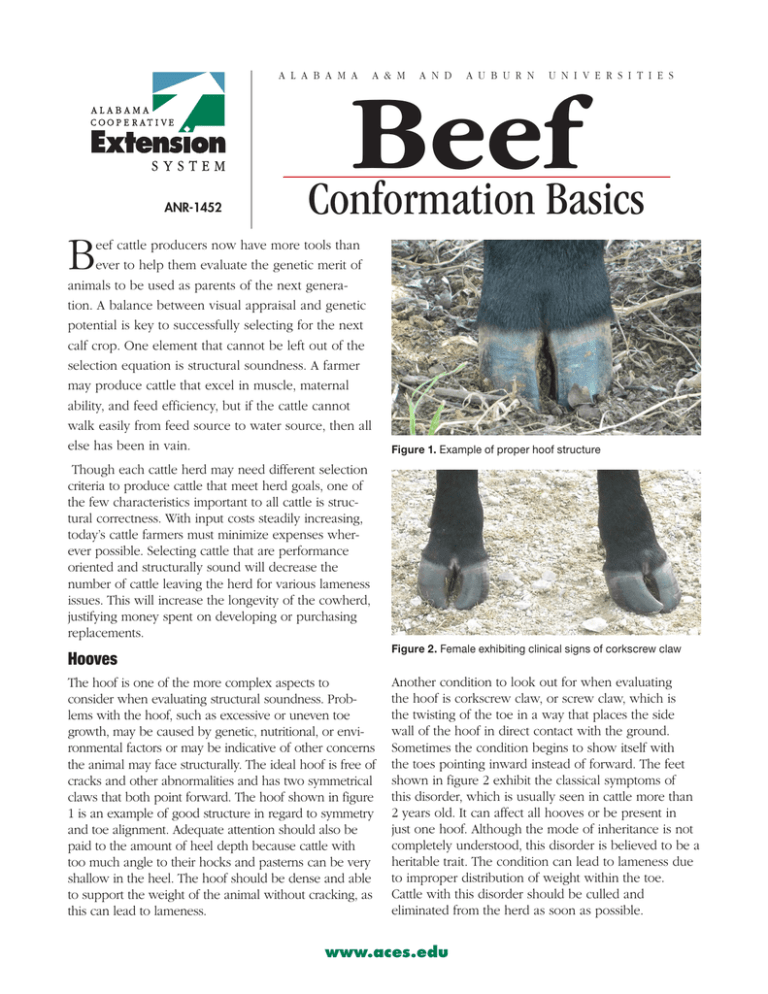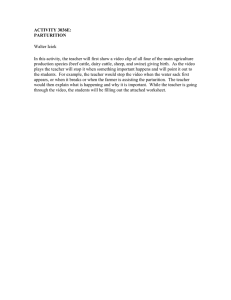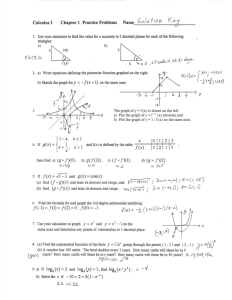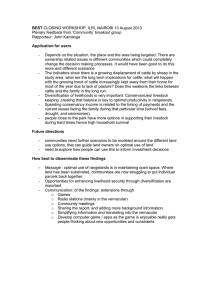
A L A B A M A
ANR-1452
A & M
A N D
A U B U R N
U N I V E R S I T I E S
Beef
Conformation Basics
B
eef cattle producers now have more tools than
ever to help them evaluate the genetic merit of
animals to be used as parents of the next generation. A balance between visual appraisal and genetic
potential is key to successfully selecting for the next
calf crop. One element that cannot be left out of the
selection equation is structural soundness. A farmer
may produce cattle that excel in muscle, maternal
ability, and feed efficiency, but if the cattle cannot
walk easily from feed source to water source, then all
else has been in vain.
Figure 1. Example of proper hoof structure
Though each cattle herd may need different selection
criteria to produce cattle that meet herd goals, one of
the few characteristics important to all cattle is structural correctness. With input costs steadily increasing,
today’s cattle farmers must minimize expenses wherever possible. Selecting cattle that are performance
oriented and structurally sound will decrease the
number of cattle leaving the herd for various lameness
issues. This will increase the longevity of the cowherd,
justifying money spent on developing or purchasing
replacements.
Hooves
Figure 2. Female exhibiting clinical signs of corkscrew claw
The hoof is one of the more complex aspects to
consider when evaluating structural soundness. Problems with the hoof, such as excessive or uneven toe
growth, may be caused by genetic, nutritional, or environmental factors or may be indicative of other concerns
the animal may face structurally. The ideal hoof is free of
cracks and other abnormalities and has two symmetrical
claws that both point forward. The hoof shown in figure
1 is an example of good structure in regard to symmetry
and toe alignment. Adequate attention should also be
paid to the amount of heel depth because cattle with
too much angle to their hocks and pasterns can be very
shallow in the heel. The hoof should be dense and able
to support the weight of the animal without cracking, as
this can lead to lameness.
Another condition to look out for when evaluating
the hoof is corkscrew claw, or screw claw, which is
the twisting of the toe in a way that places the side
wall of the hoof in direct contact with the ground.
Sometimes the condition begins to show itself with
the toes pointing inward instead of forward. The feet
shown in figure 2 exhibit the classical symptoms of
this disorder, which is usually seen in cattle more than
2 years old. It can affect all hooves or be present in
just one hoof. Although the mode of inheritance is not
completely understood, this disorder is believed to be a
heritable trait. The condition can lead to lameness due
to improper distribution of weight within the toe.
Cattle with this disorder should be culled and
eliminated from the herd as soon as possible.
www.aces.edu
Figure 3. Calf exhibiting a lack of appropriate angle
to his pastern
Figure 5. Calf exhibiting the appropriate amount of angle
to his pastern
Pasterns
Figure 4. Calf exhibiting a considerable amount of angle
to his pastern
2 Alabama Cooperative Extension System
Pasterns are also important to consider when evaluating
structural correctness in beef cattle. The pastern is
generally understood to be the joint between the
cannon bone and the hoof. They play a role in both
providing cushion and support as cattle walk and stand.
The ideal slope of the pastern is between 45 and 47
degrees. Cattle whose pasterns have an angle between
45 and 47 degrees are more desirable because this
allows the joints to function properly. Figures 3 and
4 show two calves at opposite ends of acceptability.
The calf in figure 3 is minimally acceptable in terms of
having enough angle to his pasterns to provide enough
cushion and support. The calf in figure 4 has considerably more angle to his pastern, which in turn provides
more flex and cushion when walking. If the pastern
angle becomes greater than what is seen in figure
4, support can become an issue as the animal gains
weight. Of the two extremes, cattle that lack enough
angle, or set, to their pasterns (figure 3) generally will
have more lameness issues and decreased longevity in
the herd when compared to cattle with too much set.
The pastern shown in figure 5 is closer to what should
be considered ideal. It is critical to closely evaluate feet
and leg structure of all cattle in the herd because these
are the foundation of every animal. Poor structure will
quickly force an otherwise genetically superior animal
out of the herd.
Stifle
Stifle
Hock
Hock
Pastern
Pastern
Figure 6. Example of a sicklehocked steer
Figure 7. Example of a post-legged female
Hind Legs
Hind leg structure is one of the primary indicators of
an animal’s ability to move efficiently. Evaluating cattle
while they are walking is one of the most efficient
ways to gauge structural soundness. One way to determine if the angle of the hock is correct is if the rear
foot is placed in the tracks left by the front foot when
the animal is moving forward. Cattle with the ability to
do this are usually structurally sound in regard to their
hind leg conformation.
Large angles at the hock can seriously restrict the
animal’s length of stride as far as the hind legs are
concerned. When the angle of the hock is too large, the
stifle, hock, and pastern are all pulled into a formation
that is too linear to allow for adequate flexibility and
proper function. Animals that suffer from this condition
are said to be post legged. This condition causes problems for both market and breeding animals.
Both males and females that are post legged are
usually less efficient and less durable in a pasture. In
conditions in which cattle need to cover large areas
for forage, structural integrity is of utmost importance.
A similar statement can be made in regard to feedlot
settings in which cattle need to be structurally sound
in order to compete for feed. In regard to reproduction, bulls that are post legged can face issues when it
comes to breeding due to the extreme angle of their
hind legs and the fact that these legs support the bull’s
weight during the act of breeding. These bulls may also
face issues when it comes to traveling the distances
associated with covering large groups of females in
larger pasture settings.
Just as the angle at the hock can be too large, it can
also be too small, or acute. Cattle with this condition
are commonly referred to as sickle hocked. With this
condition, the angle of the hock is too small, and cattle
usually have their hind legs and hooves placed too
far underneath them. Cattle that are sickle hocked can
sometimes overstep the hoof prints left by their front
hooves. Although sickle-hocked cattle can also have an
abnormal gate, this condition is far less detrimental to
longevity and mobility than the short, inefficient strides
seen in post-legged cattle.
The importance of being able to assess hind leg
structure in beef cattle is vital to assessing potential
longevity of the animal as it relates to structural
integrity. Although no method is fail-safe, evaluating the
pastern, hock, and stifle in order to see how they align
is a solid step. Ideally, these three joints will align in an
angle between 140 and 145 degrees. The calves shown
in figures 6 and 7 are examples of sickle-hocked and
post-legged cattle, respectively. Figure 8 shows a
145-degree angle between stifle, hock, and pastern,
which would fall into the ideal range.
Beef Conformation Basics
3
Animal’s Head
Stifle
Bottom of shoulder
Knee
Hock
Pastern
Pastern
Figure 8. Correct structure desired for
angle between stifle, hock, and pastern
Ideal
Calf kneed
Buck kneed
Figure 9. The different joint alignments associated with conditions seen in
the front leg
Front Legs
The alignment of joints in the front leg also plays a
considerable role in the structural correctness and
mobility of a beef animal. More than 50 percent of the
animal’s weight must be supported and carried by its
front two legs. In order for that to be done effectively,
the joints must be able to provide some shock absorption and allow considerable range of motion. The
ideal angle for the scapula, or shoulder, in relation to
the ground is approximately 45 degrees. This angle
allows for the appropriate range of motion and is
usually associated with the front legs being placed
squarely beneath the scapula. As the angle becomes
larger, range of motion is restricted, and the result is the
animal taking shorter, less efficient steps. Larger angles
can also affect the knee and result in the animal being
buck kneed. This condition occurs when the animal’s
knee is pitched forward in relation to the rest of the
foreleg. This condition can also be associated with
cattle being too straight in their front pasterns.
Evaluating the slope of the shoulder can be one of
the more challenging tasks when it comes to gauging
soundness of beef cattle. The point of shoulder and
the spine of the scapula are two of the most important
points to consider when making this evaluation. By
distinguishing these two points and evaluating their
relation to the ground, a reasonable assessment can be
made as to what the slope actually is. Another helpful
way to visualize the slope is to imagine a line from the
point of shoulder straight down to the ground. As cattle
become more vertical in terms of their scapula, the line
from the point of shoulder straight down to the ground
will be closer to the front leg itself. Other indicators as
to whether an animal is too straight shouldered include
the top of the scapula being visible above the animal’s
top line and shorter, more restricted steps when the
animal moves.
The two animals in figures 10 and 11 are examples of
some structural differences when it comes to slope of
shoulder and forelimb alignment. The calf in figure
When the angle of the scapula is too small, the usual
10 is considerably more vertical in terms of slope
result is the animal being calf kneed. This condition
occurs when the knee is positioned behind the outline of shoulder as demonstrated by the line connecting
created by the front leg. This condition is less damaging the spine of the scapula, point of shoulder, and the
ground. The line going from point of shoulder directly
to the front leg function than is the buck-kneed condito the ground also indicates a steep shoulder as it is
tion. In some situations, such as when cattle are being
confined on concrete, this condition may be considered very close to the outline of the front leg. The female
in figure 11 is closer to ideal in regard to slope of
more ideal as it provides more cushion for the front
shoulder and has considerably more space between
limb. Figure 9 shows the joint alignments seen with
point of shoulder and her front leg.
these conditions.
4 Alabama Cooperative Extension System
Figure 10. Steer exhibiting a steep or straight shoulder
Figure 11. Female with the correct amount of slope
to her shoulder
Evaluating Structure from the Rear
Evaluating Structure from the Front
When evaluating beef cattle from the rear, hooves of
the animal should point forward. However, that is not
the case in a large number of beef cattle. In many
instances, the hooves of the hind legs turn outward
instead of pointing forward. Cattle with this condition
are commonly referred to as being cow hocked. The
hocks are also usually turned inward and can be closer
together than the hooves in some extreme cases. In
milder cases, cattle are unhindered in terms of normal
productivity. The steer shown in figure 12 is slightly
cow hocked but would be considered normal, as
anything less than a 10-degree angle is considered
as normal. In some extreme cases, this condition can
result in uneven toe growth and wear. Cattle more
extreme in this condition are usually very light muscled
as is the heifer shown in figure 13.
From the front, cattle whose hooves are faced
forward are ideal. The steer shown in figure 14 is
a good example of both hooves pointing directly
forward. Much as it is with the hind legs, some
angle in the outward direction is acceptable, and
any angle of 10 degrees or less is accepted as
normal. Functionality of the front end is normally
not compromised until the outward turn approaches
30 degrees or more. Cattle with this condition are
commonly referred to as being splay footed. Cattle
that are splay footed can usually also be classified as
being knock kneed. Figure 15 is a good example of
a heifer having both of these conditions.
Less commonly seen in beef cattle is the condition
known as bowleggedness. This term is used to describe
cattle whose hooves are pointed inward on their hind
limbs. Though this term may also be used to describe a
similar condition in the front limbs, it usually describes
cattle that are farther apart at the hocks than at their
hooves. This condition is considered more serious
in terms of inhibiting proper mobility and is far less
common in comparison to the cow-hocked condition.
Another condition in beef cattle concerning the front
limbs occurs when the front hooves point inward
toward each other. Cattle exhibiting this condition are
said to be pigeon toed. This condition is rarely seen
and is detrimental to the functionality of the forelimbs.
Beef Conformation Basics
5
Figure 12. A slightly cow-hocked steer that would be considered normal
Figure 14. Steer with proper front leg structure.
6 Alabama Cooperative Extension System
Figure 13. An extremely cow-hocked female who is also
very light muscled
Figure 15. Female exhibiting the knock-kneed and splayfooted conditions
Figure 16. Female exhibiting a slight slope from hooks to pins
Figure 17. Female with ideal level hip structure
Hip Structure
Conclusion
The two points of reference to be aware of in evaluating
the hip are the hooks and pins. Both points are identified in figures 16 and 17, with the pins being the point
beneath the tail head. Although some breeds, such as
those influenced by Brahman genetics, are less likely
to be level, the ideal beef animal would be nearly level
from hooks to pins. Although it is not always the case,
a level hip normally equals a longer, more muscular hip
if for no other reason than length itself. Also, a level hip
is normally considered more eye-appealing. As the hip
becomes less level, it can become shorter and be associated with other issues such as cattle having their hind
legs placed too far beneath them. Some producers have
defended cattle with a minor slope from hooks to pins
by saying these cattle have an advantage when it comes
to calving and expelling afterbirth. As long as the slope
is not extreme, not much compromise is made in regard
to structural correctness.
Although structural correctness is just one aspect to
consider when selecting for genetically superior cattle,
it is a primary factor in the ability of cattle to perform
their desired function. Just as is the case in other
aspects of the beef cattle industry, there is an area of
acceptability when it comes to structural correctness.
This area becomes smaller or larger in regard to what
end of the spectrum you are evaluating cattle. Animals
retained or purchased for the purpose of breeding
stock have a considerably smaller margin of error
when it comes to structure, especially when compared
to those cattle being sent to market. There is a line that,
regardless of position in the cattle industry, should not
be crossed when it comes to perpetuating cattle that
are unfit.
One of the more problematic arrangements of the
hip can be found when cattle are higher at their pins
than at their hooks. In females, this can lead to problems with calving and expelling afterbirth. Although
the calving problem is only expressed in females,
breeding bulls exhibiting this characteristic should
be selected against as well in order to not perpetuate
the characteristic.
Cattle used in breeding programs need to be correct
in terms of structure to survive in a pasture-type
setting as well as perform the functions required of
breeding stock. The ideal time to evaluate structure
is when identifying replacements for the breeding
herd. At this time, detrimental characteristics can be
avoided, thus reducing the risk of potential problems
down the road. Avoiding structural issues initially is
considerably easier than trying to remove them from
the breeding herd later.
Beef Conformation Basics
7
David L. Daniel Jr., Graduate Student, and Lisa A. Kriese-Anderson, Extension Specialist
and Associate Professor, Animal Sciences, Auburn University. Photo credits: Bob McGuire, figure 6; Jon C. Whitlock, figure 7; George M. Richburg Jr., figures 15, 16, and 17; David L. Daniel,
all other figures.
For more information, call your county Extension office. Look in your telephone directory
under your county’s name to find the number.
Published by the Alabama Cooperative Extension System (Alabama A&M University and
Auburn University), an equal opportunity educator and employer.
New April 2013, ANR-1452
ANR-1452
© 2013 by the Alabama Cooperative Extension System. All rights reserved.
www.aces.edu





